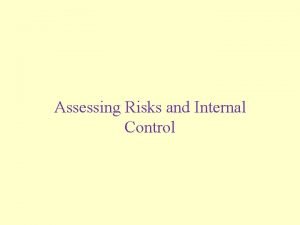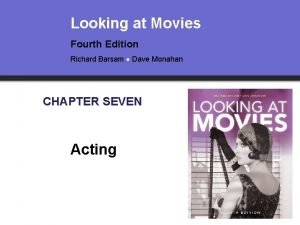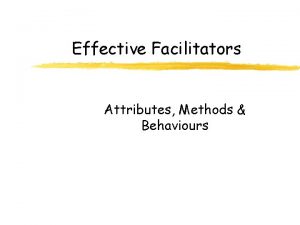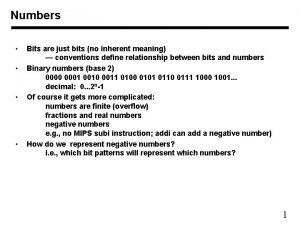CHAPTER 10 GAME TESTING 1 Game Testing Inherent






























- Slides: 30

CHAPTER 10 GAME TESTING 1

Game Testing Inherent in the concepts of prototyping and iteration is an understanding that high-quality testing is absolutely necessary to good game design. 2

Topics Why Playtest? Being a Great Playtester Circles of Playtesters Methods of Playtesting – – Informal Individual Testing Formal Group Testing Formal Individual Testing Online Playtesting Successful Student Playtesting Example: Skyrates Other Types of Game Testing 3

Why Playtest? The answer should be pretty obvious But testing is frightening – It's asking people to point out everything bad about your game But every person who plays your game and gives you feedback will make your game better However, you need to get honest feedback – Some people will try to not hurt your feelings – Schell suggests saying: "I need your help. This game has some real problems, but we’re not sure what they are. Please, if there is anything at all you don’t like about this game, it will be a great help to me if you let me know. " 4

PLAYTESTERS VS. INVESTIGATORS In the industry, "playtesters" is sometimes used to mean the people playing the game and sometimes used to refer to those running the tests. In this book, the terms are defined: – Investigator - A person administering a playtest, usually someone on your team – Playtester - A person taking part in the playtest by playing games and giving feedback 5

Being a Great Playtester Think out loud – Tell the investigators what you're thinking as you play – This is especially important on the first play through a game Reveal your biases – It's difficult for investigators to know where their playtesters are coming from – As you're playing talk about other games, films, books, experiences, etc. that the game reminds you of Self-analyze – Help the investigators understand your reactions to the game – Don't just say "I feel happy. " – It's better to say "I feel happy because the jumping mechanic makes me feel powerful and joyful. " 6

Being a Great Playtester Separate elements – Give overall feedback first – Then try to analyze art, game mechanics, game feel, sound, music, etc. as individual elements – This is akin to saying "The cellos sound out of tune, " rather than "I didn't like that symphony. " Don't worry if they don't like your ideas – As a fellow game designer, you should tell the investigators any ideas you have to make their game better – But you also shouldn't be offended if they don't use them – Both game design and playtesting are about checking your ego at the door 7

The Circles of Playtesters Playtesting should be done in stages – Game testing will expand through several circles of playtesters – Each circle of people increases in size – Each circle can help with different aspects of your playtesting 1 st Circle: You – The designer should be the most frequent playtester of a game – When making a digital prototype, every time you press the Play button in Unity, you're acting as a playtester – Your job is to determine whether the game is heading toward the kind of experience your team wants to create – Your skills as a playtester are most useful in the very early stages of prototyping – However, you eventually need to show your game to others 8

The Circles of Playtesters 2 nd Circle: Trusted Friends – Once you've iterated to the point that your game approximates the experience you were seeking, it's time for more playtesters – The 2 nd Circle is trusted friends and family members • Preferably those in your target audience or the game dev community • Members of the target audience will give you good feedback from the point of view of your future players • Game developers have the experience to give you very good feedback – Many game bugs will be found by this circle • This is the first time that anyone who didn't make the game is playing it • They will find many bugs in places you just didn't think to look – Because they approach gameplay in a different way • This will often also be the first real test of the server if it's an online game 9

TISSUE PLAYTESTERS Tissue Playtester – An industry term to describe a playtester who is brought in to play the game only a single time A playtester can only see a game for the first time once Tissue playtesters are critical for testing – The tutorial system – The first few levels – The emotional impact of any plot twists or surprises – The emotional impact of the end of the game 10

The Circles of Playtesters 3 rd Circle: Acquaintances and Others – Once the game seems pretty solid, and the 2 nd Circle has stopped finding bugs, it's time to expand – Finding people outside of those you know well can help tremendously here • Because people you know well often share your tastes and biases • You need to get out of you social circle to hear new reactions to a game – Where do you find more people? • Local universities – See if the university has a student game development club and visit them – Try setting up your game in the quad (with campus permission) • Local game stores / Malls – People head to these places to buy games, so it could be a fantastic place to get some playtest feedback • Farmers markets / Community events / Parties 11

The Circles of Playtesters 4 th Circle: The Internet – The Internet can be a scary place • Anonymity ensures that there is little or no accountability – The Internet is also the largest possible circle of playtesters – If you're developing an online game, you're eventually going to have to reach out to the Internet and see what happens • Internet users will find the most rarified bugs • Make sure that they have an easy way to report them – You must also have automated data and user tracking in place • Collect information on every single play session of your game • Much of the best information from this circle will be aggregate data • Covered in the "Online Playtesting" section that follows 12

Methods of Playtesting Several different methods of playtesting – Informal Individual Testing • You casually show the game to a friend – Formal Group Testing • You have several people play the game at once and give feedback – Formal Individual Testing • A focused analysis of single person's first play through the game – Online Playtesting • Automated analysis of thousands of online play sessions 13

Methods of Playtesting: Informal Individual Testing Casually ask a friend if she'd mind trying out your game – Most useful in the early stages of game development – Great for testing a new feature Things to keep in mind during the test – Don't tell the playtester too much • Try just giving her the game and seeing what she does • This tests how intuitive your game mechanics are • Eventually you'll learn the minimum instruction you need to give – Don't lead the player • Don't ask leading questions that may bias the playtester • "Did you notice the health items? " is a leading question – Informs the player that there are health items – Implies that it's important for her to collect them • When the game is released, you won't be there to help new players 14

Methods of Playtesting: Informal Individual Testing Things to keep in mind during the test – Don't tell the playtester too much – Don't lead the player – Don't argue or make excuses • As with everything in design, your ego has no place in a playtest • Listen to all feedback from your testers, especially if you disagree with it • This isn't the time to defend your game • It is the time to learn what you can from the person who is taking time out of her day to help improve the design improve – Take notes • Keep a small notebook with you & take notes on any feedback you get • Especially if it's not what you expected or wanted to hear • Collate these notes & look for statements that you heard multiple times • If only one playtester said something, don't worry about it as much 15

Methods of Playtesting: Formal Group Testing Was once the primary form of testing for large studios Several people are invited to a lab to play the game – – – Each person is given an individual station where she can play Playtesters are given little instruction and start playing After about 30 minutes, playtesters are stopped They are then asked to fill out a post-game survey Investigators sometimes interview the playtesters as well Good for getting feedback from many different people Can also help get many answers to some important questions 16

Methods of Playtesting: Formal Group Testing Example post-game survey questions – "What were your three favorite and three least favorite parts of the game? " – Provide the playtester with a series of images from the game • "How would you describe the way you felt at these points in the game? " • Images are much better for this than trying to describe the location – "How do you feel about the main character (or other characters) in the game? " – "Did your feelings about the main character change over the course of the game? " – "How much would you pay for this game? / How much would you charge for this game? " – "What were three most confusing things about the game? " 17

Methods of Playtesting: Formal Group Testing All formal testing requires a script The script should answer the following questions: – What should investigators say to the playtesters to set up the game? • What instructions should they give? – How should investigators react during the playtest? • Should they ask questions if they see a playtester do something interesting or unusual? • Should they provide any hints to playtesters during the test? – What should the environment be like for the playtest? • How long should the playtester be allowed to play? – What specific survey questions should be asked of the playtester once the playtest is complete? 18

Methods of Playtesting: Formal Group Testing Formal investigators should not be part of the development team – All members of the team are already biased about the game • They know how to play • They already know any secret locations or plot twists • They have an emotional investment in people liking the game – Team members could unintentionally bias or lead playtesters Once you've found a good external investigator, keep working with her – This allows the investigator to have insight into • The progress of the game • The evolution of playtesters' reactions to the game 19

Methods of Playtesting: Formal Individual Testing A detailed analysis of a single playtester's experience playing the game Based on the practices of Usability Testing Record several different simultaneous data streams – The game screen - You want to see what the player is seeing – The playtester's actions - You want to see the control input attempted by the player – The playtester's face - You want to see the player's emotions – Audio of what the playtester says - What she says can give you some information about her internal thought process – Internal game data log - Your game should also be logging time stamped data about its internal state • Covered later in the "Automatic Data Logging" section 20

Methods of Playtesting: Formal Individual Testing Running a formal individual playtest – Make test environment similar to the eventual play environment • If testing a console game, give the playtester a couch and large TV • For PC games, a desk and office chair are more appropriate – Make the playtester as comfortable as possible • Provide drinks and snacks, restrooms, etc. • Tell the playtester how much you appreciate her taking the time to play your game and give you feedbak • Ask her to please think out loud • Ask her to help you find the problems with the game – After the play session • An investigator should sit with the playtester and discuss her experience • Record this session as well 21

Methods of Playtesting: Online Playtesting The game must be in the beta phase before beginning large online playtests (often called "Beta Tests") – Remember: Beta means that all known bugs are fixed! Three forms: – Closed • Invite-only test with a small number of people • Find hidden bugs before a larger audience sees the game – Limited • Generally open to anyone who signs up • But there a limited number of spots available • Keeps the server from getting overhwelmed – Open • Anyone can sign up • The final test of any server before launch 22

Successful Student Playtesting Example: Skyrates (http: //skyrates. net) was developed at Carnegie Mellon by a team of four students – 2008 Gleemax Silver Award for Strategic Gaming at the IGF Release Schedule: New release every Wednesday – Even Weeks - Started new round; added features – Odd Weeks - Bug fix releases (fixed the new features) 16 -Week Initial Development Time (for v 1 of the game): – – – Week 8 - Closed online test (12 playtesters in the same building) Week 10 - Closed online test (25 playtesters in the same building) Week 12 - Closed online test (50 playtesters in various locations) Week 14 - Limited online test (125 playtesters) Week 16 - Limited online test (250 playtesters) Post-Development - Open online beta test (≈1000 playtesters) 23

AUTOMATED DATA LOGGING ADL occurs when your game automatically records information about itself for every play session Example: Crazy Cakes for Pogo. com – Crazy Cakes is a fast-paced bakery management game – Data logged on each round of the game • Timestamp • Player user ID • Difficulty level and round number • Final player score • Number of tokens earned (tokens are the currency of Pogo. com) • Number and type of power-ups used by player • Number of patrons served • Total number of desserts served to patrons 24

AUTOMATED DATA LOGGING Pogo. com has hundreds of beta testers – In only three days, generated data for 25, 000 play sessions! Data analysis – Entered data from 4000 randomly-selected sessions into Excel – Sorted by difficulty level and round number – Analyzed average score and token generation by difficulty – Used this data to balance • Goal scores and "expert" scores for each difficulty level and round • Rarity and usefulness of each power-up – After balancing was complete • Randomly selected data from another 4000 sessions • Checked that the balancing was still valid with different sessions 25

Other Types of Game Testing Focus Testing – Gather a group of people in a game's core demographic (a focus group) and get their reaction to a prospective game's • Look • Premise • Music • Or other aesthetic or narrative elements – Sometimes used by large companies to help determine the business case for development of a game Interest Polling – Use social network sites or crowdfunding sites to poll the level of consumer interest in a game – Can be useful for small companies trying to make sure there is a market for their game – Can also raise funds to complete the game 26

Other Types of Game Testing Usability Testing – Formal Individual Testing uses Usability Testing techniques – Tests how well testers can understand use the interface for a piece of software – Important to also do individual usability testing • Investigates how easily the playtester can interact with and gain critical information from your game • Includes testing – Various layouts for on-screen information – Several different control configurations – Any other aspects of user interface and interaction 27

Other Types of Game Testing Quality Assurance (QA) Testing – Focused on finding bugs and ways to reliably reproduce them – Entire industry devoted to this kind of testing – Core elements are: • Find a bug (a place where the game breaks or doesn't react properly) • Discover & write down the steps required to reliably reproduce the bug • Prioritize the bug – Does it crash the game? – How likely is it to occur for a normal player? – How noticeable is it? • Tell the engineering team so that they can fix it – QA is most often done by the development team and a group of game testers hired for the final phase of a project – Also possible to set up ways for players to submit bugs • but most players don't have the training to generate really good bug reports that include clear steps for reproducing the bug 28

Other Types of Game Testing Quality Assurance (QA) Testing – Many free bug tracking tools are available • Bugzilla, Mantis Bug Tracker, Trac, etc. Automated Testing – A piece of software attempts to find bugs in your game or game server without requiring human input – Automates testing methods include • Simulating rapid user input – Example: hundreds of clicks per second all over the screen • Inundating a server with thousands of requests per second – Determines the level of server load that could cause the server to fail – Can effectively test your game in ways that are very difficult for human QA testers to accomplish – Several companies specialize in automated testing 29

Chapter 10 – Summary Game testing is a critical part of the iterative process Implement the types of testing that are best for your project The types of testing you use will change over the course of the project Next Chapter: "Math and Game Balance" – Learn about the math beneath many game systems – Explore the probability that game designers should know – Learn how math can help balance games 30
 Adjectives classification
Adjectives classification Inherent powers examples
Inherent powers examples Inherent drama example
Inherent drama example Full faith and credit clause
Full faith and credit clause Inherent powers
Inherent powers Inherent powers
Inherent powers Inherent vice definition
Inherent vice definition Nonmail
Nonmail Erm implementation roadmap
Erm implementation roadmap Acceptable audit risk
Acceptable audit risk Inherent risk vs control risk
Inherent risk vs control risk Desired audit risk
Desired audit risk Inherent vice of capitalism
Inherent vice of capitalism Efpia
Efpia Green engineering principles
Green engineering principles Elastic clause def
Elastic clause def Service induced discontinuity
Service induced discontinuity Inherent drama advertising
Inherent drama advertising Calculation of goodwill in partnership
Calculation of goodwill in partnership Inherent thoughtfulness and emotionality
Inherent thoughtfulness and emotionality Inherent tone of ciliary muscle
Inherent tone of ciliary muscle Brehmstrahlung
Brehmstrahlung Inherent vs implied powers
Inherent vs implied powers Inherent resolve meaning
Inherent resolve meaning Facultative hypermetropia
Facultative hypermetropia Inherent optical properties
Inherent optical properties Elastic clause political cartoon
Elastic clause political cartoon What is inherent instability
What is inherent instability Qoc notation in hci
Qoc notation in hci Exi inherent
Exi inherent Domain testing
Domain testing

















































